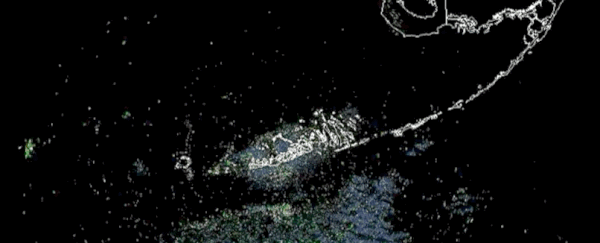Sometime around the stroke of midnight on February 17, weather radars on the island city of Key West in Florida were swarmed not by a gust of wintry showers, but by a storm of migrating birds.
At one point blanketing the entire island, this flock's radius stretched at least 145 kilometres (90 miles) wide, according to local meteorologists.
A GIF produced by the local National Weather Service (NWS) station shows the massive cloud of migrating birds in green and yellow, along with a smattering of rain in darker blue.
"Key West radar has had a busy night, but not because of weather," NWS Key West tweeted.
"The most impressive display of migratory birds so far this year occurred overnight."
📡 Key West radar has had a busy night, but not because of weather! The most impressive display of migratory birds so far this year occurred overnight. This product shows biological targets in green/yellow flying north over the Keys. Showers/rain are depicted in darker blues. 🐦 pic.twitter.com/V2PJfucxJA
— NWS Key West (@NWSKeyWest) February 17, 2020
This massive migration, which can include hundreds of thousands - if not millions - of birds, takes place starting around February each year, but it usually occurs under the cover of night while we're busy sleeping.
Over the next few months, researchers from Cornell University figure more than 118 species of bird will start returning to North America after wintering in Central and South America or the Caribbean, including sandpipers, sparrows, orioles, flycatchers, warblers, martins and thrushes.
Still, even in such huge numbers, these birds are stealthier than you'd think. Traversing huge distances using only the stars and Earth's magnetic field as guides, conditions have to be just right for us or our radars to notice anything peculiar.
Incidentally, it was a remarkably still night when Key West was smothered by a migrating flock from Cuba.
"There was kind of a stable layer of air above us that was deflecting the radar beam closer to the surface," meteorologist Kate Lenninger told the Tampa Bay Times.
"So, we were able to pick up more low level objects."
In this case, that meant birds upon birds upon birds, probably sparrows, wrens, warblers and kites.
But the island was never the destination for these birds, just a tiny part of a much larger journey. For instance, the pectoral sandpiper (Calidris melanotos), which is known to fly over this region, makes a round trip each year totalling some 30,000 kilometres (19,000 miles), so it doesn't have much time to stop and enjoy Florida's beaches.
After several hours, this massive flock of birds had moved beyond Key West, and according to meteorologists in Miami, they landed safely on the mainland just before sunrise.
